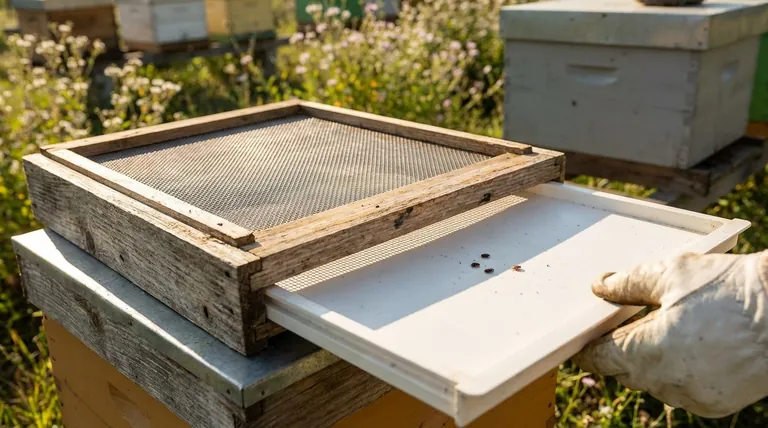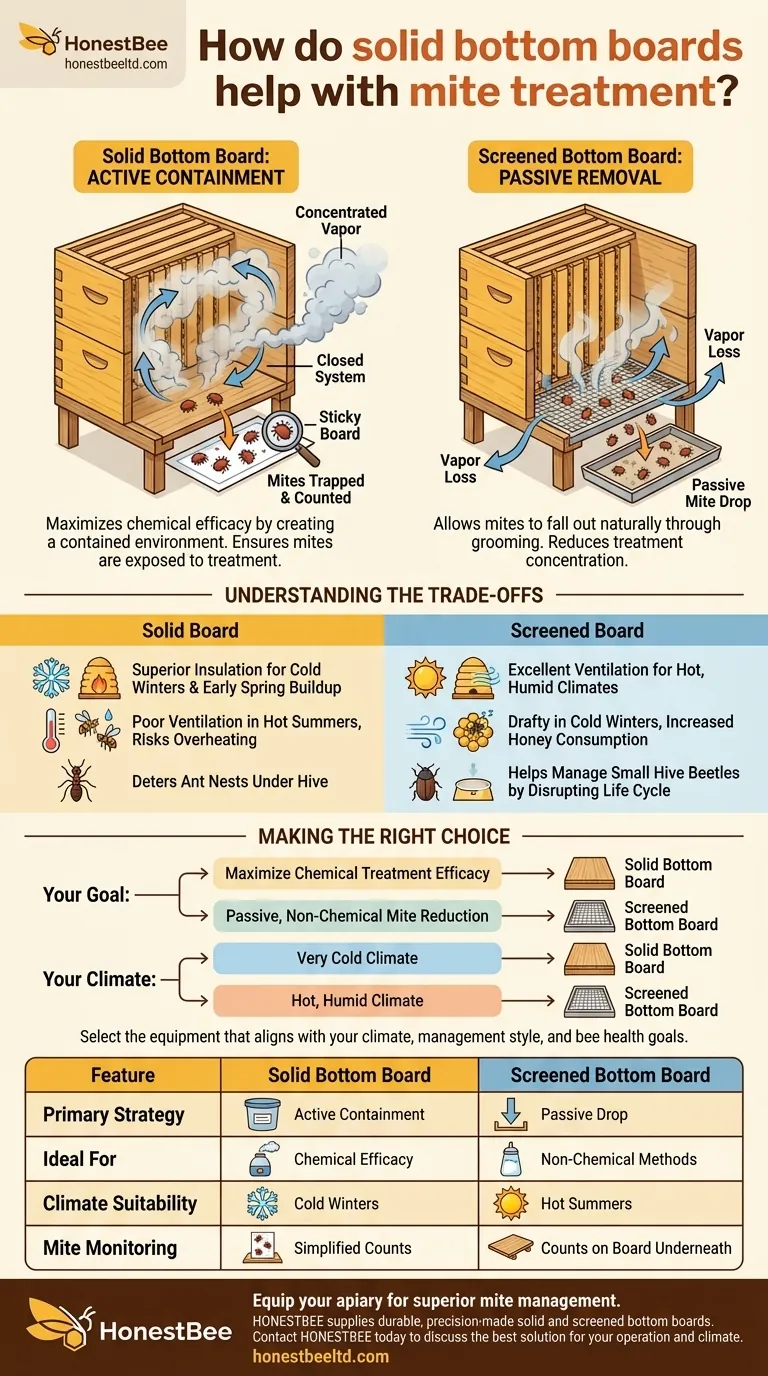In short, solid bottom boards create a contained environment for mite treatments. When using chemical applications like vaporizers or strips, a solid floor ensures the treatment stays concentrated within the hive and that dislodged Varroa mites cannot escape. This enclosed system maximizes the efficacy of the application by ensuring mites are exposed to the treatment and drop onto a surface where they can be counted.
The choice between a solid and screened bottom board is a choice between two distinct mite management philosophies: actively containing mites for targeted chemical treatments (solid) versus passively allowing mites to fall out of the hive (screened).

The Solid Bottom Board's Role in Treatment
A solid bottom board fundamentally changes the hive into a closed box. This characteristic is the key to its effectiveness during certain types of mite interventions.
Creating a Closed System
A solid board prevents the escape of vapor-based treatments, such as those using oxalic acid. Just as you would close the windows before fumigating a room, the solid board ensures the treatment circulates and permeates the hive for maximum impact.
With a screened bottom, much of this vapor can be lost through the bottom, potentially reducing the treatment's effectiveness or requiring modifications to temporarily close the screen.
Simplifying Mite Counts
After a treatment, it is critical to measure its success by counting the number of dead mites that drop off the bees. On a solid bottom board, these mites fall directly onto the floor of the hive.
Beekeepers can easily insert a white "sticky board" or oil-coated sheet to catch and count the fallen mites, providing a clear and accurate measure of the mite load and treatment efficacy.
How Screened Bottoms Approach Mite Control
While solid boards are about containment for active treatment, screened bottom boards operate on a principle of passive removal.
Encouraging Passive Mite Drop
During their natural grooming behaviors, bees will often dislodge Varroa mites. With a screened bottom board, a significant percentage of these mites fall directly through the screen and out of the hive.
This passive mite reduction happens continuously, helping to keep the overall mite population lower without any direct intervention from the beekeeper.
Enabling Non-Chemical Methods
Screened bottoms are ideal for certain non-chemical pest management techniques. For example, the "sugar shake" method involves dusting bees with powdered sugar, which encourages grooming and causes mites to lose their grip.
The mites then fall through the screen, where they can be counted on a sticky board placed underneath the hive. This provides a way to monitor mite levels without harming the bees.
Understanding the Trade-offs
Neither bottom board is universally superior; each comes with distinct advantages and disadvantages that depend on your climate and beekeeping goals.
Solid Board: Insulation vs. Ventilation
A solid bottom board provides superior insulation. It helps the colony retain heat during winter, which can reduce food consumption and improve survival rates in cold climates. It also encourages an earlier brood buildup in the spring.
The downside is poor ventilation in hot, humid summers, which can cause the colony to overheat and lead to "bearding," where large numbers of bees cluster on the outside of the hive.
Screened Board: Ventilation vs. Winter Hardiness
A screened bottom board offers excellent ventilation, which is a major advantage in hot climates. It reduces bearding and helps the colony regulate its internal temperature more easily.
However, in cold climates, the constant airflow can create a draft, forcing the bees to consume more honey to generate the heat needed to keep the cluster warm through winter. Many beekeepers who use screened bottoms will insert a closure board during the winter months.
The Impact on Other Pests
Solid bottom boards can deter ants from building nests directly under the hive. Screened bottoms, by allowing debris to fall through, can help manage small hive beetles by disrupting their life cycle and making them vulnerable on a sticky board below.
Making the Right Choice for Your Hive
Your decision should be based on a clear understanding of your specific goals, management style, and local environment.
- If your primary focus is maximizing chemical treatment efficacy: A solid bottom board is the better choice to create a closed, contained system.
- If your primary focus is passive, non-chemical mite reduction: A screened bottom board is superior, as it allows mites dislodged by grooming to fall out of the hive.
- If you are beekeeping in a very cold climate: A solid bottom board's insulation is a significant advantage for winter survival and early spring buildup.
- If you are beekeeping in a hot, humid climate: A screened bottom board provides essential ventilation to prevent the colony from overheating.
Ultimately, understanding these fundamental differences empowers you to select the equipment that best aligns with your climate, your management style, and the long-term health of your bees.
Summary Table:
| Feature | Solid Bottom Board | Screened Bottom Board |
|---|---|---|
| Primary Mite Strategy | Active containment for chemical treatments | Passive mite drop through grooming |
| Ideal For | Maximizing chemical efficacy (e.g., vaporizers) | Non-chemical methods (e.g., sugar shakes) |
| Climate Suitability | Superior insulation for cold winters | Essential ventilation for hot, humid summers |
| Mite Monitoring | Simplifies counts with a sticky board on the floor | Allows for counts on a board placed underneath |
Equip your apiary for superior mite management. HONESTBEE supplies durable, precision-made solid and screened bottom boards to commercial apiaries and distributors. Whether your strategy relies on targeted chemical treatments or passive control, our equipment is designed to support the health and productivity of your hives. Contact HONESTBEE today to discuss the best bottom board solution for your operation and climate.
Visual Guide

Related Products
- Australian Pine Wood Langstroth Screen Bottom Board for Wholesale
- Langstroth Screen Bottom Board for Beekeeping Wholesale
- HONESTBEE Wooden Bee Escape Board with Triangle Mesh Design for Beekeeping
- HONESTBEE Multi Exit Plastic Bee Escape Board for Efficient Honey Harvesting
- HONESTBEE Durable Frame Wiring Board with Integrated Tensioner
People Also Ask
- How should the screened bottom board be used throughout the year? A Guide for Healthy Hives
- What features does the screened bottom board with insert offer? Essential Tools for Hive Health and Pest Control
- Are screened bottom boards necessary for beekeeping? A Strategic Choice for Modern Hive Health
- Why has the Cypress Screened Bottom Board become popular in the last decade? Essential for Varroa Mite Control & Hive Health
- What are the pros and cons of a screened bottom board? Optimize Hive Health for Your Climate



















